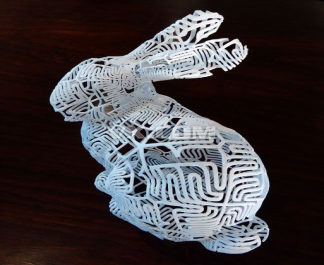
Romeo Edmead is using his fingers to unlock a world he has never experienced before. Edmead lost his sight when he was just two years old, so he has always had a complicated relationship with art and museums.
Although he has heard of classical paintings, he says school trips to museums were uncomfortable. “I knew what my friends would experience, but I wouldn’t necessarily experience it because they could use their sense of sight and I didn’t have that,” said Edmead. He describes running his fingers over a 3D version of Emanuel Leutze’s “Washington Crossing the Delaware” at a library for the blind in New York City, as a kind of “freedom”.
“In life we’ve all heard of famous painters and their works. But to me, that’s all they were,” he said. “They were like vocabulary words I could write down on the page but I didn’t necessarily know how to put a physical picture together. Something like this presents that opportunity and that freedom to get a better understanding. ”
The man behind the 3D printed works is John Olson. A former photographer for LIFE magazine, Olson co-founded a company called 3D Photoworks that developed and patented their own printing process for works of fine art. “We begin with taking a conventional two dimensional image and change it to 3D data. Once that data has been changed, we send it to a machine that sculpts the data. It gives that image length, width, depth and texture. And once that’s been sculpted, it goes through a printing process, which produces a three dimensional print with length, width, depth and texture,” said Olson.
It took Olson seven years to develop the method, but now he’s moving full speed ahead. He’s raising money to scale up the production. “There are 285 million blind and sight impaired world-wide. One person goes blind in the U.S. every 11 minutes. So our goal is to make art and photography available to them, first in this country and then beyond,” said Olson.
1.What can we know about Romeo Edmead’s childhood from the passage?
A He went to school with sighted kids.
B He used memory when appreciating art.
C He enjoyed visiting museums with his friends.
D He was always interested in classical paintings.
解析:选A。A 推理判断题。根据第二段第一二句可知,学校 组织了博物馆之旅,而在该旅行中,他的朋友可 以正常参观博物馆而他自己却不能,这让他感觉 很不舒服。由此可推断他和视力正常的孩子上一 样的学校。故选 A。
2.What does the underlined word “this” in Paragraph 3 refer to?
A The feeling about touching a 3D printed work.
B The way of putting physical paintings together.
C The 3D printing technology.
D Writing vocabulary words on paper.
解析:选C。C 词意指代题。在触摸3D打印艺术品之前Romeo Edmead 无法欣赏一张画,而有了它,便能更好 地理解画了,由此可推断此处 this 应指 3D 打印 技术,故选 C。
3. How many steps are there in the 3D printing process according to While Olson?
A Two.
B Three.
C Four.
D Five.
解析:选B。B 推理判断题。根据第四段可推断有三步,第一 步是“taking a conventional two dimensional image and change it to 3D data”,第二步是“send it to a machine that sculpts the data”,第三步是“it goes through a printing process”,故选 B。
4. It can be inferred from the last paragraph that _________.
A it is not easy to develop the 3D printing technology
B it is uncommon for blind people to take photos
C the 3D printed works are now popular in the world
D there is now a decreasing number of blind people
解析:选A。A 推理判断题。根据最后一段“It took Olson seven years to develop the method, but now he’s moving full speed ahead.”可推断发展 3D 打印技术是不容 易的,故选 A。